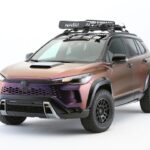Kia’s 2027 Telluride Wears Artistic Camouflage Wrap Before LA Auto Show Debut
Kia just revealed the 2027 Telluride in the most creative way possible: wrapped in custom camouflage that simultaneously hides and reveals the redesigned flagship SUV. Rather than typical development vehicle camo with random patterns, Kia Design Center America created an artistic wrap using overlapping design sketches, warm-to-cool color gradients, and artistic influences that transform the pre-production Telluride into rolling automotive art.
The cleverly disguised SUV appears in new images and video tackling serious off-road terrain in California’s Alabama Hills, demonstrating capabilities while keeping actual production sheet metal hidden until the November 20 global debut at the Los Angeles Auto Show.
The Artistic Approach to Camouflage
Tom Kearns, Vice President and Senior Chief Designer at Kia Design Center America, explained the unconventional thinking behind this wrap: “We looked at the many different patterns used by carmakers to obscure the shape of vehicles in development and decided to approach the project from a different angle. We determined that hiding the all-new Telluride in plain sight could be done in a way that is both eye-catching and thought-provoking.”
Instead of random swirls or geometric patterns designed purely to confuse the eye, Kia’s team used hundreds of actual design sketches from the Telluride’s development process. Overlapping outlines from different angles create the wrap’s foundation, with intersecting lines obscuring profiles, curves, and angles while revealing the design journey.
Close inspection shows the many directions designers explored before finalizing the production form. It’s simultaneously camouflage and design history—hiding the final product while documenting the creative process that led there.
Kearns positioned this as embodying “Opposites United in itself”—connecting the beginning and end of the design process through a single visual treatment.
Opposites United Design Philosophy
The wrap execution reflects Kia’s broader Opposites United design philosophy introduced by Karim Habib (Executive Vice President, Head of Kia Global Design) in 2021. This approach draws inspiration from contrasts found in nature and humanity, creating visual identity that evokes positive forces and natural energy through contrasting combinations of sharp elements and sculptural shapes.
Opposites United rests on five principles:
-
Bold for Nature
-
Joy for Reason
-
Power to Progress
-
Technology for Life
-
Tension for Serenity
How a camouflage wrap embodies all these principles is somewhat abstract, but the concept of revealing through concealing—showing design process while hiding final product—certainly qualifies as oppositional unity.
Artistic Influences: Haring and Mr. Doodle
Kearns cited two specific artistic influences: Keith Haring and Mr. Doodle (Sam Cox). Both artists create complex patterns expressed through simple lines—Haring’s iconic figures and Mr. Doodle’s intricate doodle artwork fill spaces with repetitive line work creating overall compositions from accumulated detail.
“We worked on reducing the Telluride’s design sketches to simple lines, overlapping sketches and silhouettes to create what ultimately became the defining motif for the wrap,” Kearns explained.
This reduces automotive design’s typical complexity—curves, surfaces, proportions, details—into essential linework. The result looks genuinely artistic rather than purely functional camouflage, which makes it effective marketing theater even if it’s less effective at actually hiding the vehicle’s shape.
Color Strategy: Warm to Cool Gradient
Color selection received careful consideration beyond just picking something attention-grabbing. The wrap features warm-to-cool color shifts starting with orange at the front and transitioning to purple at the rear.
The orange coordinates with amber daytime running lights at the front, while purple contrasts at the rear as orange’s opposing color on the color wheel. This creates visual flow from front to back while maintaining complementary color theory principles.
Kearns noted they tested many color combinations and gradations before settling on this orange-to-purple progression. Given how much automotive design involves color selection iteration, that tracking makes sense—though the final choice does create distinctive visual impact.
Easter Egg: Telluride Coordinates
Subtle map coordinates appear along the lower edges of the front doors: 37.9375° N, 107.8123° W. These pinpoint Telluride, Colorado—the ski resort town after which the SUV is named.
It’s a small detail most people will miss, but enthusiasts who notice appreciate these touches. Easter eggs in automotive design have become increasingly common as manufacturers recognize engaged fans scrutinize details.
Alabama Hills Off-Road Testing
The video showcasing the camouflaged Telluride was shot in Alabama Hills—a formation of rounded rocks and eroded hills in California’s high desert created by geologic uplifting 100 million years ago. The jagged Sierra Nevada peaks provide dramatic backdrop.
Russell Wager, VP of Marketing at Kia America, positioned this as intentionally different from typical camouflaged vehicle photos: “Pictures of camouflaged development vehicles are commonplace, especially for automotive enthusiasts. And they typically depict the vehicle parked or driving on the highway. But we wanted to do something special with this pre-production Telluride.”
The video montage shows the Telluride tackling steep inclines, sandy washes, water crossings, and rocky terrain—”extreme overlanding adventure highlighting Telluride’s off-road capabilities.”
Whether this actually demonstrates meaningful capability or just shows that any modern SUV with decent ground clearance can navigate maintained off-road trails depends on how challenging the terrain actually was. The video editing and dramatic scenery make it look impressive regardless.
What This Actually Reveals
Despite the artistic camouflage, certain details are visible:
The overall size and proportions appear evolutionary rather than revolutionary—this looks like a Telluride, just updated. The roofline, greenhouse shape, and general stance don’t suggest radical departure from current generation.
Lighting signatures at front and rear show updated designs, though specifics remain obscured by the wrap and editing.
The off-road sequences suggest Kia wants buyers perceiving the Telluride as capable beyond suburban school runs and Target parking lots. Whether that translates to actual hardware upgrades (better 4WD system, improved approach/departure angles, underbody protection) or just marketing positioning remains unclear.
The Marketing Strategy
This camouflage reveal represents sophisticated marketing execution. Rather than just showing the vehicle or keeping it completely hidden until the official reveal, Kia created middle ground that generates buzz while maintaining mystery.
The artistic wrap provides visual interest justifying media coverage and social media sharing. The off-road setting positions the Telluride as adventurous rather than purely practical. The design sketch overlay educates consumers about the design process while creating exclusive feeling—you’re seeing early development work normally kept internal.
Russell Wager’s comment about wanting “to do something special” acknowledges that simply showing camouflaged vehicles no longer generates the attention it once did. Manufacturers must create compelling narratives and visuals to cut through constant automotive content flow.
Production Telluride Expectations
The actual 2027 Telluride debuts November 20 at the Los Angeles Auto Show. Based on competitive pressures and market evolution, expect:
Updated exterior design maintaining recognizable Telluride character while incorporating newer Kia design language
Revised interior with larger screens, updated materials, and improved technology integration
Powertrain updates—possibly hybrid options given industry trends toward electrification
Enhanced driver assistance systems bringing the Telluride current with class standards
Whether Kia actually improves off-road capability or just markets it better remains to be seen. The current Telluride handles light trails adequately but isn’t built for serious off-roading. If Kia adds off-road-specific trim (X-Line or similar) with upgraded hardware, the Alabama Hills video makes more sense. If it’s just marketing, it’s selling capabilities the vehicle doesn’t genuinely possess.























